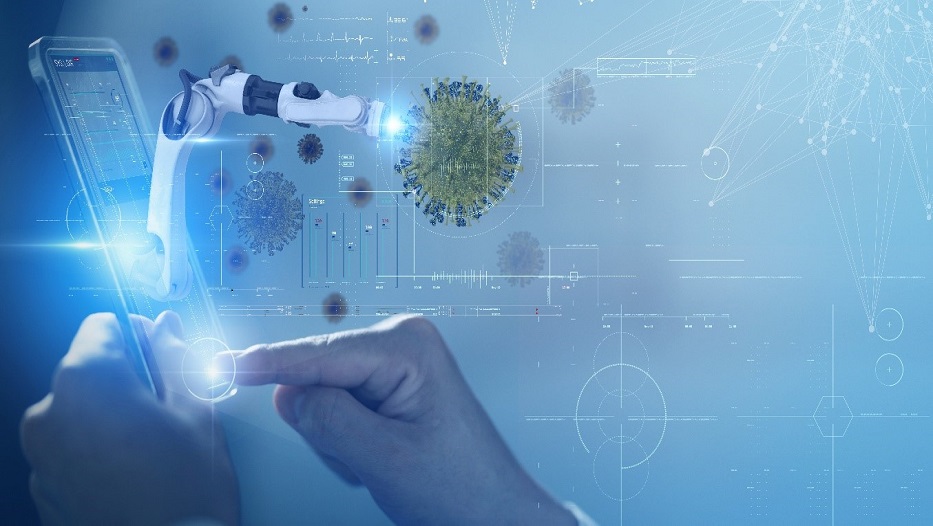admin | 08/09/2020
The world we live in is changing. It has been for some time. But the emergency unleashed by the spread of COVID-19 has accelerated development of certain emerging technologies, which have today become a flood barrier allowing the scientific community to progress towards a common goal: limiting the virus and its impact.
The dizzying spread of the coronavirus is breathing life into the most recent technologies and creating cooperation between them. The ability to produce and collect data, knowledge, and talent from tech companies, paired with their rapid response, has driven them to be today’s best economic and social guide.
“The entire world has turned to tech and scientific institutions in search of answers,” stated Xavier Ferràs, tenured lecturer of Operations, Innovation, and Data Sciences at ESADE. For him, if anything has kept its authority and increased its importance throughout the pandemic, it has been these two disciplines, the alliance of which seeks to halt the spread of the virus and mitigate the negative impact.
A springboard for transformation
For years we have been talking about the importance of technological innovation, but if there were any uncertainty about its importance as a driver of competitiveness, the worldwide health crisis removed all doubts.
“Geolocation systems or 3D printing to produce ventilators, networks of supercomputers fed by powerful AI algorithms that examine molecular geometries at light speed to find the fastest path to the coveted vaccine” are some of the advances that Xavier Ferràs noted as an example of emerging technologies that are powerful weapons to limit the pandemic. They are excellent support used by “biotechnologies throughout the world for large-scale competition and cooperation in a race against time to find the vaccine or medicines that weaken the effect of COVID.”
The goal is not to emphasize the impact of a specific solution, but rather to recognize the transformational role that digitalization is playing in processes, strategies, and organizational culture. Although not every country has had the same results when taking advantage of the opportunities that emerging technologies offer.
In this context, well organized national systems of innovation are benefiting to a greater degree from these new processes and knowledge. Ferràs highlighted the model of South Korea, where there is large-scale investment in R&D and they are able to reorient their objectives at high speed. “Their biomedical and digital clusters quickly got to work under the government’s leadership to provide the entire population of South Korea with medical detection devices and digital infection location systems within a month,” the expert in innovation and digital transformation specified.
This shows that all the players and institutions are essential to harness them. For Xavier Ferràs, “work must be done as a value chain.” It’s not only about the importance of R&D in labs (which is extremely important), but also about the ability to produce industrial-level solutions.
Strategic industries
Throughout the pandemic, supply chains have experienced unprecedented disruption that shows the need for closer production systems. As Ferràs explained, the configuration of globalization is exploring new strategies in terms of industry.
So far, “the key factor was the cost: industries moved to locations with lower labor costs.” However, now, “industry is modernizing and becoming more independent of geography. It will relocate to areas around R&D centers to accelerate innovation cycles,” specified the expert, who believes that we will see the emergence of innovative superclusters, producers of strategic technologies.
There’s no going back now. “In the post-COVID world, technology will be essential as a factor of competitiveness, prosperity, and health,” Xavier Ferràs noted. Investment in intelligent R&D, focused on human, health, social, and economic problems will be essential in predicting future crises.
For this expert, knowledge and technology are the only weapons available to fight a pandemic. That’s why we must learn these lessons and put R&D into full gear.
COVID has been the catalyst. “What was going to happen in 10 years will happen in 10 months,” stressed the professor specializing in Operations, Innovation, and Data Sciences at ESADE, for whom the important lesson from this crisis is that R&D should not only be part of election platforms, but should also be included in public budgets.
In addition, another important factor to take into account is the ability to generate and collect data and knowledge. Xavier Ferràs remembers a prominent American analyst who said, “Aggregating data is aggregating power, and today only large tech corporations and totalitarian states aggregate data.”
But the race isn’t over here. Ferràs believes that there will be an avalanche of disruptive digital technology, enabled to rewrite the operating system of society and the world’s economy.
Primary technological tools
The report “Insights from COVID-19: Technology and innovation against the Coronavirus” by the advisory firm Grant Thornton highlighted that 53% of the innovative initiatives launched to help in light of the coronavirus have used big data and artificial intelligence, 22% robotics, and 12% cyber security. Blockchain (11%) and chatbots (2%) took third and fourth place. What were the primary tools and their achievements?
Artificial intelligence. Using algorithms reduces time for diagnosis thanks to the analysis of lung images; it monitors changes in body temperature through portable sensors in real time and provides a data platform to track the spread of the disease.
Certain AI applications are taking part in an active search for treatments by scanning medicine databases. It has also been used to create new molecules that could be used as potential medicines and even reduce the time necessary to predict the secondary structure of the virus’s RNA, in addition to collaborating to identify fake news about the disease.
Robotics. Robots have assumed mechanical tasks such as delivering food or medicine to isolation wings and disinfecting, helping to reduce contact with patients. Additionally, they help to reduce time in decision-making, improve workers’ abilities, can be used to predict problematic situations and foresee solutions.
In addition, drones have been useful to spray disinfectant in potentially infected areas, reminding people about the need to stay at home, and ensure food and medicine is delivered to areas in quarantine.

Developing applications focused on practicing telemedicine can provide the competent institutions with the knowledge of infectious disease experts in locations where they have no access to specialized resources.
Blockchain. Using blockchain improves the supply of healthcare material both in hospitals and in the logistic chain. It could additionally provide a robust, transparent, and economical method to facilitate decision-making, collaborate in insurance payment management, and monitor donations.
Creating “accounting books” would help in outbreak monitoring, diagnosis accuracy, treatment effectiveness, data monitoring and exchange between researchers, while ensuring the reliability of data from clinical trials.
Telemedicine. Developing medical applications prevents the collapse of health services while reducing transmission of the disease in hospitals. In addition, these tools can provide the knowledge of infectious disease experts in locations where they have no access to specialized resources. Additionally they improve effective triage, classification of patients prior to their arrival at the emergency room, and coordination of care for probable COVID-19 cases or people who have been exposed to a confirmed COVID patient.
3D Printers. This technology has been essential in supplying materials to hospitals when supply chains were overwhelmed. Thanks to the collaboration of various manufacturers who shared design files and guidelines to work as one, respirators and medical material were 3D printed. Similarly, newly created products are being produced, such as plastic doorhandle adapters that can be easily opened with elbows to prevent the spread of the virus.
Article contributor:
 Xavier Ferràs is an telecommunications engineer with a degree from the UPC. He has a Master’s in Business Administration (MBA) from ESADE and holds a PhD in Management Sciences (UB).
Xavier Ferràs is an telecommunications engineer with a degree from the UPC. He has a Master’s in Business Administration (MBA) from ESADE and holds a PhD in Management Sciences (UB).
An expert in innovation and digital transformation, he is a tenured lecturer of Operations, Innovations, and Data Sciences at ESADE. Additionally, he is a member of the advisory board of AMEC (Association of International Industrial Companies), AMETIC (Association of CIT Companies), the Fundación PIMEC (Small and Midsize Companies of Catalonia), chair of the scientific board of IND+I (Initiative for Industry and Innovation in Viladecans), and member of the board of experts of COTEC.
Among other executive positions associated with technology innovation, he was the director of the Center for Business Innovation at ACCIO (Catalan Agency of Competitiveness), supervising policies of cluster development, R&D, and technology transfer in Catalonia.





